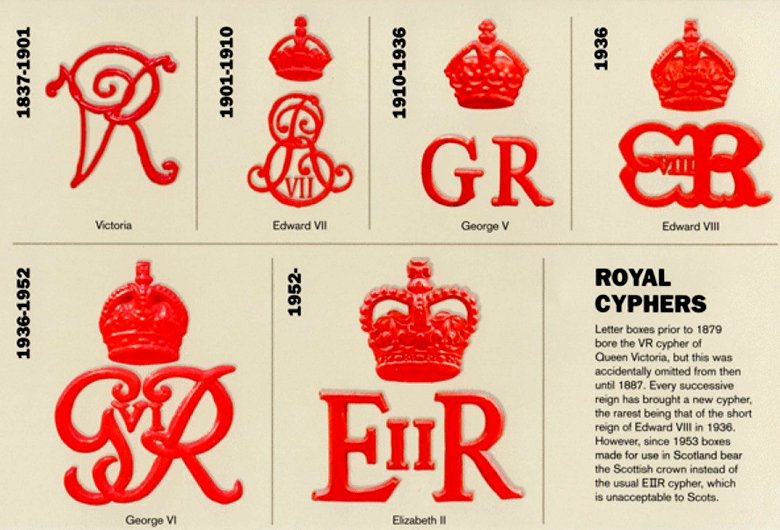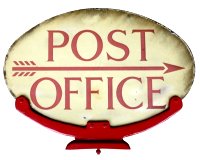| 1 Type B Pillar Box on the corner of the High Street and Woodhill Park.
The Royal Cipher shows this Pillar Box was made in the reign of George VI between 1936 and 1952. |
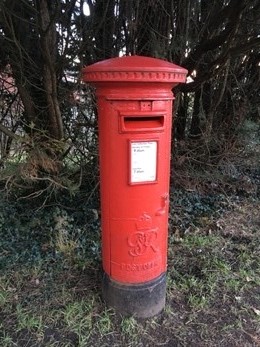
|
| 2 Type B Pillar Box outside Pembury Pharmacy, High Street.
The Royal Cipher shows this Pillar Box is from the reign of our current monarch, Queen Elizabeth II so dates from 1952 onwards.
Note the bracket on the top which originally held a ‘Post Office
Directional Sign’. The bracket would have been angled so that the arrow
pointed to the Post Office. When it was decided to remove the sign, the
Engineer should have collected the post box keys from Tunbridge Wells,
unscrewed the bracket from the inside and then fitted a bolt cover over
the bolt hole before returning the keys to Tunbridge Wells. As this was
time consuming, Engineers would often use a lump hammer to break the
bracket instead as what appears to have happened to this post box. Source: The Letter Box Study Group.
Below is an example of the sign attachment.
Picture S016 on this page show the Post Office sign on top of the box.
Streets Photos
|
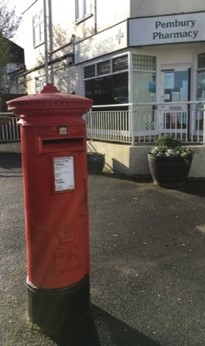
|
| 3 Type B Pillar box on Hastings Road, at the top of Bellfield Road.
This Pillar Box is positioned outside the former Post Office at 47 Hastings Rd.
It dates from the reign of George V between 1910 and 1936. |
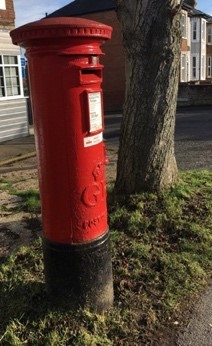
|
4 George VI Wall Box (1936-1952) on Bo Peep Corner.
(Junction of Henwood Green Rd & Hastings Rd).The 1938 map below
shows an ‘LB’ for Letter Box in the same location as the existing Wall
Box. It is likely the current Wall Box is the same one as shown on the
map.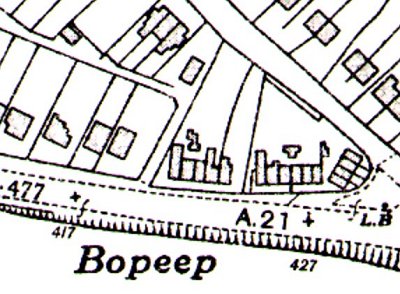 |
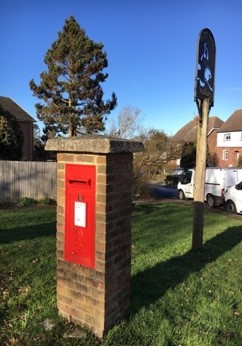
|
| 5 George V Wall Box (1910-1936) on the corner of Henwood Green Road/Canterbury Road.
The Kelly’s Directory of 1916* makes reference to a Wall Letter Box
in Canterbury Road. As 1916 is within the reign of George V and the
current Wall Box in Canterbury Road has a GR Royal Cipher, it is likely
to be the same Wall Box from 1916. The map from 1938 below shows ‘LB’
for Letter Box in the same location as the existing Wall Letter Box.
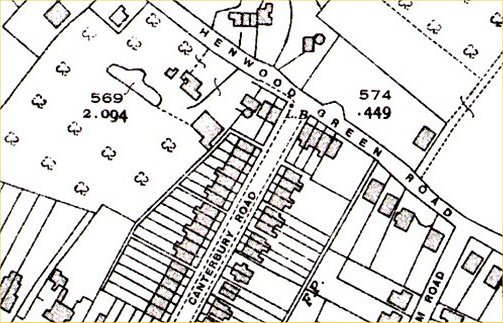 |
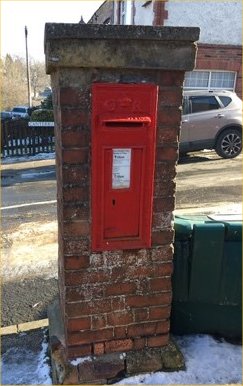
|
| 6 George VI Wall Box (1936-1952), Romford Road.
Approx mid way between Henwood Green Rd and Heskett Park. |
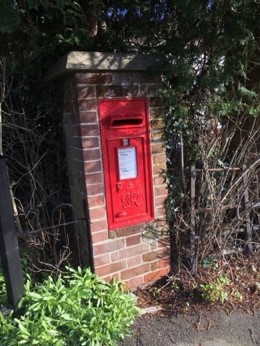
|
| 7 Elizabeth II Lamp Box, Romford Rd, near Romford Farm from 1952 onwards. |
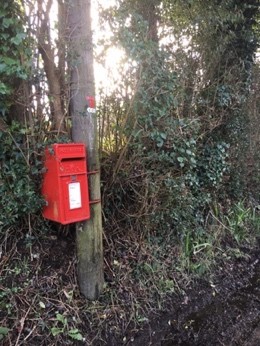
|
| 8 Victorian Wall
Box, Little Stanton House, Woodside Road. Dates before 1901. The oldest
Post Box in Pembury. In Mary Standen’s Pembury in old picture postcards,
Nicky Stiles, a postman circa 1910 “would stand by the post box at
Stanton House and blow a whistle. The people living there knew that they
had five minutes to post any letters. Nicky cleared the box at 7 p.m.
He would receive a nice Christmas box each year as a reward for this
service.”
Kelly’s Directories from 1898, 1903 and 1904 refer to a Wall Letter
Box at ‘Romford’. As the current Stanton House Wall Box is Victorian so
made before 1901, it is possible that the ‘Wall Letter Box’ referenced
in Kelly’s at Romford is actually the one at Stanton. The 1892-1905 map
below shows an ‘LB’ for Letter Box at Stanton House. The 1911 Kelly’s
Directory lists Wall Letter Boxes at Romford AND Stanton House. It is
possible that the Romford Letter Box referred to in the 1916 Kelly’s
Directory* is a new one and the Victorian Wall Box is re-referenced as
“Stanton House”.
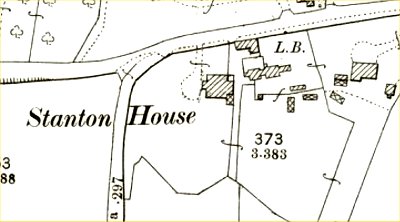 |
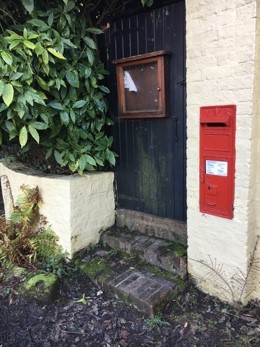
|
| 9 Type B Pillar Box
on the corner of Lower Green Road and Church Road. It has an Elizabeth
II Royal Cipher so dates from 1952 onwards.
A pillar box was outside the Post Office (72 Lower Green Rd) on the
other side of the road. This may be the same one that has been moved. |
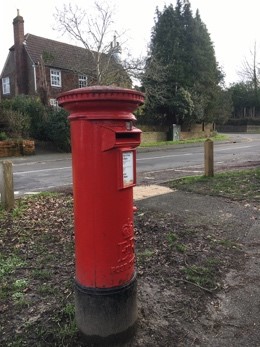
|
| 10 A recent Elizabeth II Lamp Box on the corner of Amberleaze Drive.
This was installed after the George V Pillar Box was removed from Lower Green Road (next to the current pedestrian crossing). |
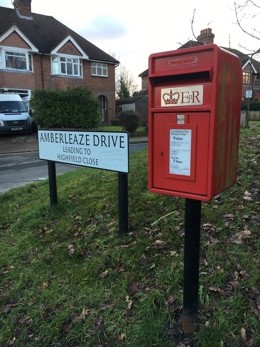
|
| 11 Lower Green Road, by pedestrian crossing near Belfield Rd path.
Removed when item 10 (above) was installed |
|
12 72 Lower Green Road. Post Office – Kings. Brick post box to right of shop.
No longer present. Type unknown.King’s Stores and Post Office existed
from 1965 to circa 1974. However, the Wall Post Box set in a pillar of
bricks in the image could have been installed earlier than 1965. A circa
1922 image of the same shop run by Mr Beeching does not show the same
Wall Box. It follows it was installed between 1922 and 1965 so was
likely to be either a George V, George VI or Elizabeth II Wall Box. |
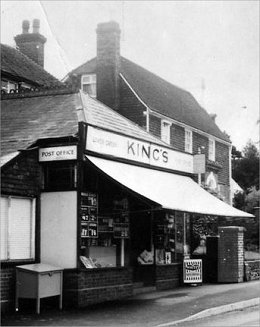
|
13 72 Lower Green Road. Post Office – Beeching.
Embedded post box under right-hand shop window, next to man in
apron.Enhanced portion of picture shows the box has 3 levels of text –
V (crown) R
Post Office
Letter Box
No longer present. Type unknown.
Prior to 1910, it was the postmaster’s responsibility to provide a
letter box at his premises at his own expense. Poorer postmasters would
get a local carpenter to make a box known as Carpenter’s Box. From 1910,
the Post Office rescinded this unfair requirement. Source: Letter Box Study group |
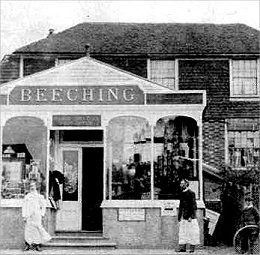
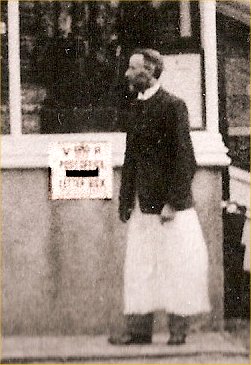 |
14 47 Hastings Road. Post Office.
The Post Office moved to 47 Hastings Road (formerly 29 Hastings Road – see History of the Postal Service in Pembury)
in 1935. The unused Wall Box is a ‘Ludlow Box’ named after its maker,
James Ludlow of Birmingham. They were made in large and small versions
and this one is a large version. It dates between 1929 and 1936 so would
have had an enamel plate covering part of the box with the Royal Cipher
of George V (see example). It follows that the Wall Box was likely to
have been installed when the Post Office opened in 1935. Ludlow boxes
are made of wood with a metal facing plate and cast-iron aperture
casting. Being made of wood, they are likely to break if moved. The GRV
Wall Box at 47 Hastings Road is recorded as in use until 2004 and
painted black in 2005. Source: Letter Box Study Group
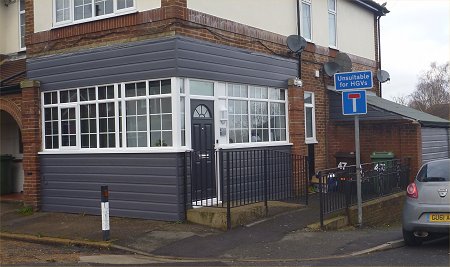
Above: post box is under the narrow window at the side of the old Post Office.
Right : Example of a large Ludlow Wall Letter Box.
George V Royal Cipher on Enamel Plate.
Believed to be how the Wall Box looked at 47 Hastings Road when in use.
|
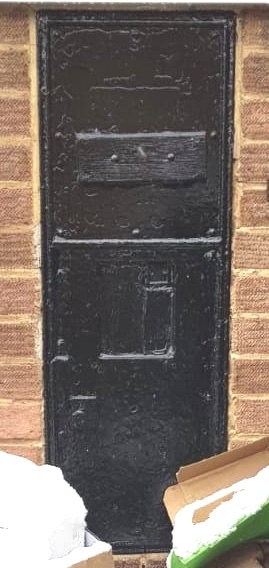 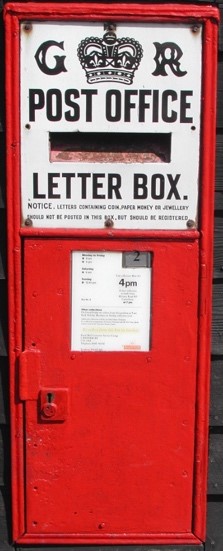 |
15 31 High Street
Embedded post box in the wall next to 31 High St (the old telephone exchange).
No longer present. Type unknown. |
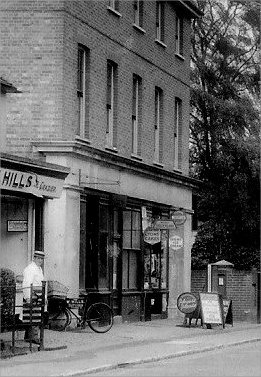
|
16 Church Road, approaching Kent College.
Queen Elizabeth II Lamp Box made from 1952 onwards |
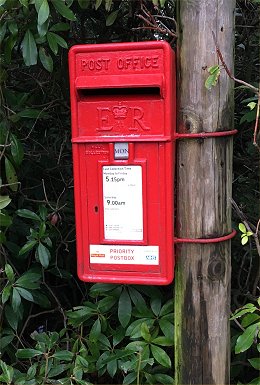
|
17 Lost 1882 Victorian Pillar Box, Lower Green?
Kelly’s Directories of 1882 and 1886 list one letter box in Pembury
namely a “PILLAR LETTER BOX at Lower Green, cleared at 5.30 p m”. As
1882 was within the reign of Queen Victoria, and assuming Kelly’s is
correct, this would have been a Victorian pillar box which no longer
exists in Pembury. The Post Office at Lower Green was established in
1887 so the V R slot in the Beechings shop image (see above) is assumed
to have been installed in 1887, five years later. No mention is made in
1892 Kelly’s Directory of a Lower Green Pillar Letter Box but the 1904
Kelly’s Directory refers to a Wall Letter Box at Lower Green. This could
be the slot in the wall of Beeching Stores. Was the Lower Green
Victorian Pillar Box removed or was it never there?Extract from the 1882 Kelly’s Directory |
|
| 18 Lost 1892 Victorian Pillar Box, Romford Road?
Kelly’s Directory of 1892 refers to a “PILLAR LETTER BOX at Romford”.
However, future Kelly’s Directories only refer to a Wall Letter Box at
Romford. Was Kelly’s correct or was the Letter Box at Romford always a
Wall Letter Box? |
|
19 Lost Wall Letter Box at Romford.
Kelly’s Directories from 1898, 1903 and 1904 refer to a Wall Letter Box
at ‘Romford’. From 1916, Kelly’s list Romford and Stanton House
separately. As the current Lamp box in Romford Road was made after 1952
(see image above) and the 1916 Kelly’s Directory* lists the Stanton
House Wall Letter Box and Romford Wall Letter Box separately, it is
possible to conclude that the Romford Wall Letter Box in the 1916
Kelly’s Directory no longer exists. |
|
20 Lost Wall Letter Box, 37 Hastings Road
The first known reference to a Wall Letter Box in the Kelly’s
Directories for Hastings Road was in 1904. The 1911, 1912, 1914, 1916*
and 1919 ** Kelly’s Directories also refer to a “Hastings Road” Wall
Letter box. The OS map from 1909 shows an ‘LB’ for Letter Box at the
end of the drive for what is now (in 2021) Anand Lodge: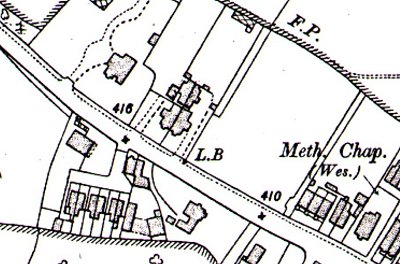
OS map 1909 and location of the former Letter Box.
A Wall Letter Box installed in 1904 during the reign of Edward VII is
likely to have had the ERVII Royal Cipher. In 1904, there was no Post
Office in Hastings Road so the Wall Letter Box could be the one shown on
the 1909 OS map above.
There is no Wall Letter Box in this location today (2021).
An example of an Edward VII Wall Box is shown here:
|
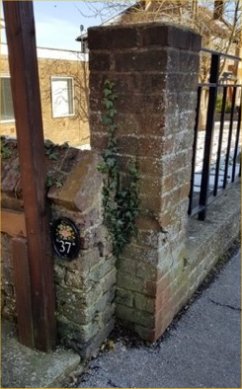
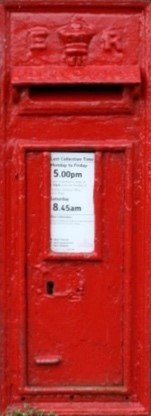
|
21 Lost Wall Box, Knight’s Place
The 1916 Kelly’s Directory* makes reference to a Wall Letter Box at
Knight’s Place. If installed in 1916, it could have been a George V Wall
Box.*Extract from Kelly’s Directory, 1916  |
|
22 Lost Wall Box/Pillar Box, Hawkwell Place
Kelly’s Directory of 1919** makes reference to a Wall Letter Box at
Hawkwell Place (now Kent College). If installed in circa 1919, it is
likely to have been a George V Wall Box.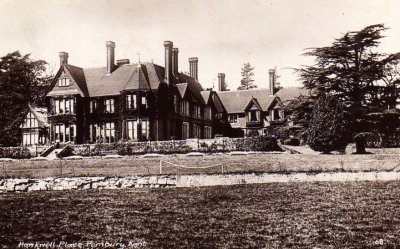
**Extract from Kelly’s Directory, 1919 |
|
23 Lost Wall Box/Pillar Box, outside Hawkwell Farm
Article 16 September, 1955 reports on a theft of a letter posted in a box outside Hawkwell Farm.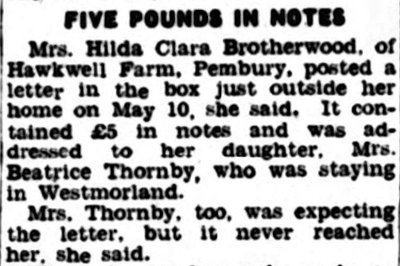 |
|


